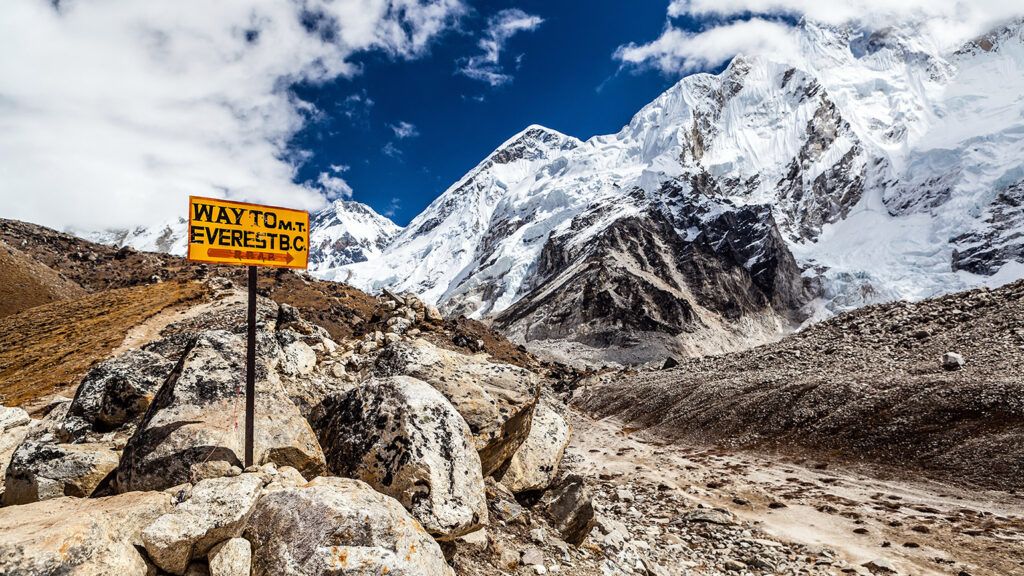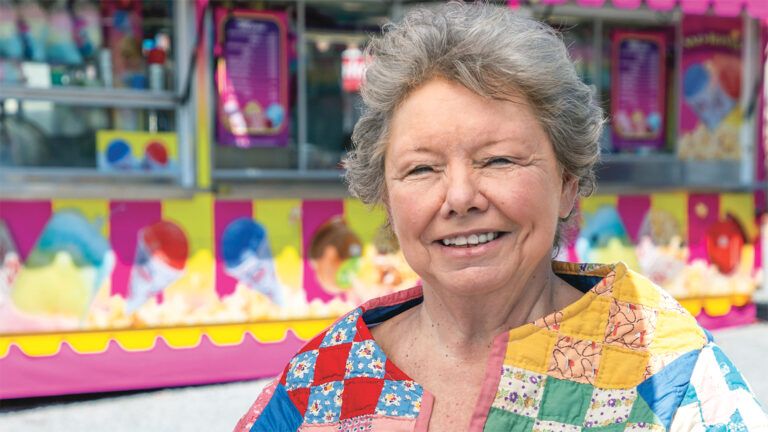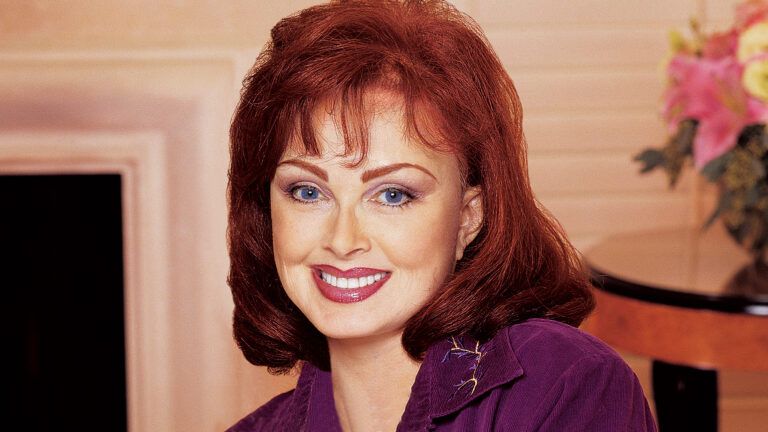Mt. Everest’s summit, the highest on earth, looms 3,000 feet above me, its outline barely discernible in the darkness.
I’ve climbed for most of April and all of May to get here, Camp Four—26,000 feet above sea level.
In a few hours, our team will begin the final all-night push to the top, a grueling effort in nearly oxygen-less air with temperatures at double digits below zero.
Will I make it all the way up and down again? A 52-year-old woman? Or will I collapse and turn back, or worse? I’ve always heard Everest is as much a mental test as physical. Now I know what they mean. Especially for someone like me.
I go over my mental checklist—extra oxygen canisters, hydrating fluid, energy bars, gloves and, of course, the banner I brought.
This is a moment I never dreamed possible 10 years ago, at the beginning of my quest to scale the Seven Summits—the highest peaks on each continent. So much has changed since then!
When I climbed Argentina’s 22,841-foot Mt. Aconcagua, only my parents and husband knew the challenge I faced. I kept it secret even from fellow climbers. I thought people would see me as a lesser person if they knew. Yet it was on that climb with Dad—the second of my Seven—I had to face something more frightening than my secret. I had to face myself.
My dad, Neal, is my closest friend and an avid outdoorsman. We set our sights on Aconcagua a few years after our first Seven Summits climb, Mt. Kilimanjaro, in 1993. That one had been to celebrate Dad’s sixty-first birthday.
Aconcagua was for Y2K. What better place to greet the dawn of a new millennium than the highest mountain in the world outside Asia? On top of Kilimanjaro, I’d never felt closer to Dad. His incredible faith, forged in running the family funeral home in Wisconsin, never failed to fortify mine. I couldn’t wait to make another climb with him.
Then came that terrible morning in January 1999, less than a year before we were to attempt Aconcagua. I awoke to a nightmare: One half of my body was numb, as if someone had drawn a line down the center of me. Soon the numbness spread. What’s happening?
Many tests later the doctor said the fateful words: multiple sclerosis. The doctor told me the disease could go into remission, but my mind froze on a line I’d heard as a child: MS—crippler of young adults. This can’t be happening to me.
My identity was centered around the idyllic Rocky Mountain High lifestyle I lived in Steamboat Springs, Colorado. I was a first-grade teacher, married, living in a beautiful house. I skied, hiked, worked out. I’d never be able to do any of those things in a wheelchair.
My friends were outdoorsy types. None of them had a serious illness like MS. How could I tell them? What would they think of me? A week later, alone, I tried to ski. I would defy MS, deny I had it. I wouldn’t give it my respect! I nearly killed myself.
When I was with friends I lived in fear that the slightest hand tremor would betray my secret. I began steroid treatments and slowly the symptoms decreased. But my fear that MS would one day leave me crippled wouldn’t loosen its grip.
By summer the stress of keeping my secret was overwhelming. I had to talk to someone. I flew home to Wisconsin to tell Mom and Dad. “Lori, no matter what, we’ll always be here for you,” Dad said. “You’re going to be all right.” Mom hugged me as hard as she could. I didn’t think she’d ever let go.
Back home in Colorado I couldn’t bring myself to talk about my MS. The months passed in a haze of apprehension. But the treatments were helping.
As fall faded into winter I was hiking miles without getting winded. I’d never stopped dreaming of climbing Aconcagua and as the date grew closer, it seemed more and more possible. Knowing Dad would be with me provided extra reassurance. He was 68. I knew this would likely be his last climb. I needed him by me, needed to feel his faith.
I told Dad I still wanted to try the mountain, but I didn’t want to tell anyone about my MS. Dad agreed to keep my secret. In December, we traveled to Argentina and began the three-day hike to the foot of the South American giant.
At base camp, 14,000 feet up in the Andes, our tent pitched on a sea of rocks, fear gripped me. What if the altitude triggered my MS symptoms? Was this just more denial, like my skiing disaster? Except that one false step here could kill me.
Five days later, at 18,000 feet, the danger hit home. I lay awake listening to a vibrant 35-year-old woman in the tent next to mine, battling high altitude pulmonary edema. I heard her deep hacking cough through the night, then moaning, then silence. She died.
The next morning we broke camp and had hiked for about an hour when Dad stopped. “This is my summit,” he said. “I can’t breathe. My head is pounding. I have to get back to base camp.”
“I’m going with you,” I said.
Dad shook his head. “This is your climb. It’s something you have to do for yourself. You can’t turn back now.” If I didn’t at least try to reach the summit, I’d always be plagued by doubt. About my illness. About myself. Dad kissed me. He started down the mountain. I watched until he faded from view.
I struggled higher with the team, but my mind was far away. Would Dad be okay? I thought about the times we’d spent together, how he’d always been there for me. Now I was on my own. Just me and my MS.
I thought about how Dad had devoted his life at the funeral home to helping people deal with loss and pain. Suddenly I understood why he wanted me to continue alone. I needed to prove to myself I was stronger than my fears. He wanted me to test my limits.
After another freezing night in our tents, we climbed to Camp Four at 19,700 feet. A day of rest and then we began the push to the summit. It was New Year’s Eve, on the cusp of a new millennium.
I slogged through snow, stumbled over rocks and dirt. Bitterly cold wind buffeted us. Every step, no matter how small, was agony. The summit felt as far away as the moon.
The guides urged us on: “Take thirty steps!” Then we were allowed a brief pause before taking 30 more. Anything less and the temptation would be too great to sit down and not get up.
A final steep, 600-foot pathway of loose, slippery rock. Visibility was awful. I felt isolated. I pushed on, rocks cascading down the trail. Then I looked up and saw a hand in front of my face.
“Grab on,” a voice said. I reached out and a guide hoisted me up. I’d made it, almost 23,000 feet above sea level. I’m sure the view would’ve been spectacular had the summit not been enveloped in clouds. But another view lay before me in the swirling mist, a view of my life.
One day I might not be able to walk. For now I’d continue my Seven Summits quest. And I’d tell the world about my MS.
Now, as I finish my dinner on Mt. Everest, I think about my tearful reunion with Dad back at base camp on Aconcagua. He’d been so proud of me.
My life changed dramatically after that. And it was anything but idyllic. My marriage dissolved. I left my job. For a time I moved home with my parents.
Then in 2002 Mom died. She taught me that every day is a gift. I wanted to spend the time I had pursuing the Seven Summits and bringing attention to MS.
In the next six years I climbed Europe’s Mt. Elbrus, Denali (Mt. McKinley) in Alaska, Australia’s Mt. Kosciuszko and Antarctica’s Mt. Vinson.
Sharing my story allowed me to meet thousands of others with MS. For many of them, just getting out of bed was a major achievement. Their struggles made Everest seem almost insignificant. “You carry all of us in your backpack,” one person wrote me.
We start climbing. Only a thin ray from my headlamp breaks the darkness. Aconcagua’s 30 steps between breaks seem a lark. Here, on Everest, our bodies scream after five. About 4:30 a.m.—after we’d climbed more than six hours in the dark—the sky begins to lighten and a breathtaking sunrise breaks across the mountain peaks.
I feel as if I’m absorbing its energy. But soon snow and clouds grow thick around us. Dear God, don’t let us turn around now. Not this close.
Three more hours of climbing, and we reach the Hillary Step, a 40-foot rock wall that can only be negotiated one person at a time using fixed ropes. I climb across boulders the size of cars, the drop thousands of feet down on either side. Don’t let fear in, I chant to myself.
The summit is ahead, but the snow is blinding. “How much farther?” I finally ask my Sherpa guide. “You see those people over there,” he says, pointing to a group a few feet ahead of us. “That’s the top.”
I’m there. There’s not a single step on earth that would take me any higher. I pull the banner from my pack in honor of the first World MS Day and unfurl it.
I think about all the people it represents. This is for you. Thanks for lending me your courage. Then I grab a satellite phone. There is one more person I need to thank. In Wisconsin a phone rings. “Dad,” I pant, “I made it. I’m on the summit.”
“Congratulations,” he says. “I’ve been praying for you. I knew you could do it. Now we’ve got to get you down.” The storm’s growing. No time to linger. But I’m not worried. Fear can be conquered, one step at a time.
Even now, in the blinding wind, the view is beautiful.





